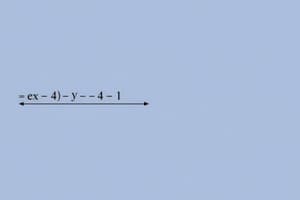Podcast
Questions and Answers
What is the value of f(9) for the function f(x) = x + 4, and what point does this correspond to on the graph?
What is the value of f(9) for the function f(x) = x + 4, and what point does this correspond to on the graph?
f(9) = 13, corresponding to the point (9, 13) on the graph.
How can you determine the average rate of change for a linear function between two x-values?
How can you determine the average rate of change for a linear function between two x-values?
The average rate of change is determined by calculating the difference in y-values divided by the difference in x-values.
Identify the y-intercept of the function y = -x + 7 and explain its significance.
Identify the y-intercept of the function y = -x + 7 and explain its significance.
The y-intercept is 7, which corresponds to the point (0, 7) on the graph where the line crosses the y-axis.
What is the slope of the linear function y = -x + 7, and how does this affect the behavior of the function?
What is the slope of the linear function y = -x + 7, and how does this affect the behavior of the function?
Explain how to graph a linear function without creating a table of values.
Explain how to graph a linear function without creating a table of values.
Flashcards
Linear Function
Linear Function
A function whose graph is a straight line.
Slope of a line
Slope of a line
The rate of change of y with respect to x; the average rate of change
y-intercept
y-intercept
The point where the graph of a function crosses the y-axis
Equation of a line
Equation of a line
y = mx + b, where m is the slope and b is the y-intercept.
Signup and view all the flashcards
Average rate of change
Average rate of change
The change in y divided by the change in x between two points on a graph.
Signup and view all the flashcardsStudy Notes
Linear Functions
- Linear functions are functions whose graphs are straight lines.
- A linear function is in the form f(x) = mx + b or y = mx + b, where m is the slope and b is the y-intercept.
Exercise #1
- The function f(x) = (2/3)x + 4 is a linear function.
- Finding f(9): f(9) = (2/3)(9) + 4 = 6 + 4 = 10. The point (9, 10) lies on the graph.
- A table of values for the function are included, plotting these points gives a straight line.
- The average rate of change between any two consecutive x-values is equal to the slope of the line. This value should be 2/3
- The y-intercept is the point where the line crosses the y-axis. It's the value of y when x = 0. In this case, the y-intercept is 4.
Linear Functions Definition
- A linear function has the form f(x) = mx + b (or y = mx + b)
- m represents the slope of the line.
- b represents the y-intercept, the point where the line crosses the y-axis.
Exercise #2
- For the function y = 5x + 2, choose two x-values, calculate their corresponding y-values, and then calculate the average rate of change.
- The average rate of change is equal to the slope of the line (m = 5).
Exercise #3 (Graphing a Linear Function)
- The given linear function is y = -x/2 + 7
- To graph, create a table of (x,y) values.
- Plot the points on the graph and draw a straight line through them.
- The slope of the line is -1/2
- The line is decreasing because the slope is negative.
Exercise #4 (Graphing Linear Equations)
- Provides several equations (y = 2x - 3, y = -x + 6 etc.)
- Find the slope and y-intercept for each equation.
- Graph these equations on a grid.
Exercise #1 (Multiple Choice Lines)
- Four lines are graphed on a coordinate plane.
- Match each graph to its correct equation.
Exercise #2 (Graphing and Identifying)
- Graph the equation y = (-3/2)x + 4 .
- Identify the slope and the y-intercept.
Exercise #3 (Average Rate of Change)
- Find two sets of coordinate points on the line.
- Calculate the average rate of change between the two coordinate pairs.
- The results is equal to the slope of the line.
Exercise #4 (Rewriting equations)
- The equation 2y - 6x = 12 is given.
- Steps are shown in the text to rewrite the equation in the slope-intercept form (y = mx + b).
- Identify the slope and y-intercept of the rewritten equation.
Exercise #5 (Rewriting equations)
- Several equations in various forms (e.g. 3y - 3x = 15) are provided
- Rewrite the equations in the slope-intercept form (y = mx + b)
- Identify the slope and y-intercept for each rewritten equation.
Studying That Suits You
Use AI to generate personalized quizzes and flashcards to suit your learning preferences.




